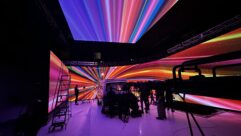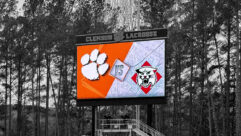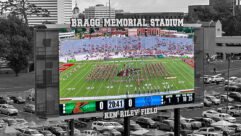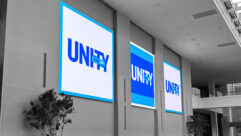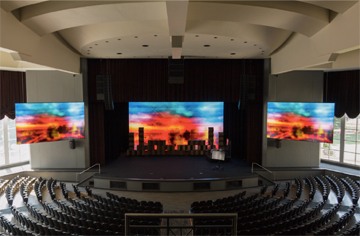
SVC Podcast – Show Notes – Show 169-1
In this edition of the SVC Podcast, Contributing Editor Bennett Liles talks with Jacob Springman and Zach Kale of Perimeter Church in Johns Creek, Georgia about their move from projection to LED displays in the church sanctuary. They are joined by NanoLumens CEO Rick Cope. While Zach and Jacob relate the story of their installation, Rick discusses the progression of LED technology and how his clients can get the most from it.
For Part 2
Links of interest:
- Perimeter Church in Johns Creek, Georgia
- NanoLumens, Indoor and Outdoor LED Displays
- Christie Spyder X20 Video Processor
Download Podcast Here:
https://s3.amazonaws.com/nb-svc/public/public/169-1_Perimeter_Church_Nan…
This is the SVC Podcast from Sound & Video Contractor Magazine with Rick Cope of NanoLumens and Jacob Springman and Zach Kale of Perimeter Church. Show notes and equipment links for the podcast are on the web site of Sound & Video Contractor Magazine at svconline.com.
With huge windows in the sanctuary, Perimeter Church in Johns Creek, Georgia installed three big LED displays from NanoLumens. We’ll get the story on that from Jacob Springman, Resident Systems Engineer and Zach Kale, Worship Leader and Venue Director. Also with us is Rick Cope, CEO of NanoLumens. That’s right here next on the SVC Podcast.
We’ve got the manufacturer and the user views on LED displays with us today and let’s start with Perimeter Church in Johns Creek, Georgia and Zach Kale. Zach, what’s your worship style at Perimeter Church? Is it a young church with live music or is it an older, maybe more conservative congregation there?
Zach: No, man, I think it’s maybe a little bit of everything. It’s beautiful. It’s young. It’s old. We’ll do a hymn and right next to that we’ll do a song that has just been written either by one of our writers or by, you know, it’s on the radio. So it’s all across the board. It’s a rich heritage of a lot of different styles and diversity of people. [Timestamp 1:23]
Sounds like you’re very focused on adopting new technology if it works for you and you’ve made a considerable investment in the new LED displays.
Zach: Oh, sure.
Rick, CEO of NanoLumens, what’s the first thing you ask a church when they express an interest in going from projection to LED displays?
Rick: How do you want to use it to communicate to the audience? Ours are so light and thin we can hang them from glass ceilings and put them in places where we otherwise couldn’t put them. So our first conversation with a church or any customer is what are you really trying to achieve and how are you trying to communicate with other people who will be looking at the screen? [Timestamp: 1:58]
When they come to you and you talk about pixel pitch and the size of the display, is it possible for a church to just go overboard and have one that’s too big?
Rick: You can, but that’s generally not the case because churches, as you would imagine, have reasonably limited budgets. [Timestamp: 2:15]
Zach, what did the church want to get out of this when they made the investment? What was the general idea of going to the LED displays?
Zach: This is strictly opinion at this point, because those are a lot of maybe-above-our-pay-grade type of discussions. Here’s what I see as happening, though, and I know the heart of our pastor is that this church has been around for 40 years and he’s closing in on stepping back and back and back over the next decade. And I know that he, just like our model of our church is to develop disciples. We’re to mature and equip and deploy disciples. And so in the same way we want to hand off discipleship to our congregation and our members. We also want to hand off our technology in a really honorable way to the next generation. And so I see our church as going you know what? This is a new technology. How can we get this now and set up the next generation for success and not just hand them an old ship that has a lot of holes and cracks and it’s sinking and going well, we love you guys. Have fun for the next decade. And so I think this is just a way of bringing us up to date. At the same time we’re remodeling our lobby and updating a lot of the facilities across the board, not just our technology side. But that was a huge driver. [Timestamp: 3:32]
What did you have before the NanoLumens displays? I assume that you were coming from a projector environment like most churches have.
Jacob: Yeah. Actually if I go back our auditorium was built in 1996 and at that time we actually had two rear projection screens built into the proscenium wall of the auditorium. And they were very small and recessed and really hard to engage with worship because they – it was sort of like looking at a TV at a very off-axis angle. So several years ago we installed front-projection screens approximately the same size as the LED walls. They were around 18 feet projection with 20,000 lumen projectors. And when we installed them we actually angled them out from the proscenium wall to make for a much more engaging experience for the congregation. And that was installed about eight years until we just converted to LED. [Timestamp: 4:24
Okay, so you’re familiar with the projector situation and all of the limitations and challenges that it has, I’m sure.
Jacob: Yes. Absolutely.
I also noticed from a picture I have that the church has huge windows in the sanctuary. That’s not your typical layout. Due to the big windows was ambient light level the problem that led to using the LED displays?
Jacob: Yeah. That was definitely one of the factors. The windows actually have shears that can be lowered and they also have blackout shades that can lower. But even with the shears down there was so much ambient light that came into the stage that it was really hard to get the screens to really pop and so a lot of times we would really keep the screens down so that IMAG or any sort of video element would look for vivid. And really now with LED it’s really like having your living room TV hung up on both sides of the stage. Regardless of the ambient light they’re bright and crisp and engaging. [Timestamp: 5:16]
Yeah, I guess glare is not a big problem now. Was it sort of a testing scenario where you had to look at it from just about every seat in the house to see what you had?
Jacob: Well, because we hung the new LED walls in the same orientation as our projection screens and we were comfortable with that location from years of use that there wasn’t glare, it really wasn’t a factor with the new screens. The architecture of the building meant that it’s really very rare that we have any direct sunlight that hits those screens and so they’re positioned for sight lines from the entire auditorium as well as just where they are there’s just a lack of glare from the outside. It really works out well. [Timestamp: 5:54]
Rick, as far as the trends involved here. How far back do we have to go to see where LED technology really started to catch on with churches?
Rick: Only a year or two.
Yes, it seems that the turn from projection to LED displays, particularly for churches has just gotten started.
Rick: LED has only become cost-effective as a replacement option for projectors in the last two years. [Timestamp: 6:16]
Okay, and the cost versus operational expense. Would that be question number one that you’re usually asked?
Rick: Not really. What we mostly see from churches and other customers is how can I use this in ways I can’t use my projector? I have to have a projector. I have to have a distance and I have to have a screen. So if I want to put a screen up I’ve got to figure out where am I going to put a projector. If you put one of our screens up you can put it anywhere so it frees from the requirement of having a projector at some distance from the screen. And then if you put that projector by a heat pool it creates a huge amount of noise and a huge amount of heat. [Timestamp: 6:50]
And another central consideration is just getting the video signal to the display. Jacob, I would think you’re still using the same method of getting the video signal to its destination. What specific type of signal conveyance are you using?
Jacob: The back end of the video system is all HD-SDI, which is what we used prior to the upgrade. So our native signal is a 1080i 59.94 format which stays in SDI where we have a router and a FOR-A production switcher on the back end. When we added the new screens we added a Spyder X20 processor which is allowing us to do some front-end processing for the screens because they’re greater than 1920 x 1080. So we actually had to split the image up into quadrants up on the side screens in two sections for the center screen. And by having that Spyder it’s given us the ability to do some more advanced routing and sizing images across the screens with the combination of a key box. So right now on the front end is essentially sources and IMAG computers hitting a FOR-A production switcher and a Spyder. And then once we leave the Spyder it leaves DVI to NanoLumens DIU processors where they convert to twisted pair. And due to length limitations we actually convert down in the basement our twisted pair to single-mode fiber which is sent up to the stage area, which is then where it’s broken back out to twisted pair that leads to each display. So the core of the system is all HD-SDI, but on the LED side it’s essentially what NanoLumens uses and we work with them to make sure that we have the right fiber and cabling infrastructure to meet their needs. [Timestamp: 8:28]
And where do you control all this from? Do you have a control room somewhere in the back?
Jacob: Yeah. In the balcony of the auditorium we actually have a control room that has a large window in it. So our graphic ops switcher/shader, if we have a technical director, will stay in the back of the auditorium where they have sight lines to the stage and the screens at all times. [Timestamp: 8:48]
And I would think you have a regular crew to operate everything. Are these mainly volunteers from the congregation?
Jacob: That is correct. It’s a combination of staff and volunteers that work the services.
Well, you’ve certainly guided them well and done a great job putting Perimeter Church on the forefront of LED display technology now. In Part 2 we’ll be talking more with all three of you about the step up to LED displays for Perimeter Church.
Thanks to Jacob Springman and Zach Kale of Perimeter Church and Rick Cope of NanoLumens for joining us on the podcast. Show notes and equipment links are on the website of Sound & Video Contractor Magazine at svconline.com. Next week we’ll get into some possible surprises after going from projectors to LED displays. That’s on the next SVC Podcast.


